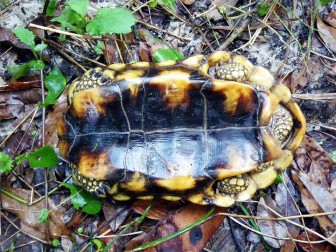Tortoises or ‘land turtles,‘ are terrestrial reptiles and unlike the turtle, don’t really go to water, except for an occasional soak or to drink. Both turtles and tortoises are reptiles, they lay their eggs in sand or sandy soil, have hard shells and are endothermic (rely on their environment to regulate their body temperature).
One of the main key differences between turtles an tortoises is that turtles live near or in water and have webbed feet or flippers and more aerodynamic shells which make them agile swimmers. Tortoises are adapted to walking and navigating the forest floor and have club like feet with slightly flattened forefeet and a highly domed shell.

The Yellow Footed Tortoise (Chelonoidis denticulata) is one of two species of terrestrial tortoise in Guyana and is often confused with the Red Footed Tortoise (the other species of tortoise in Guyana). The Yellow Foot can be distinguished by the yellowish highlights on its head, central area on the scutes (individual plates of the shell) and of course by the yellow spots on the scales of the feet. The Yellow Foot prefers the relative humidity of the rainforest (while the Red Foot is a savannah and clearing species) and has shown a tendency towards gigantism, with females reaching or exceeding 75 cm in carapace length! Males can be distinguished from females by the concave shape of the plastron (belly shell), while females have a flat plastron, a longer tail and are often heavier than the male.
Tortoises eat fruits, leaves, mushrooms, carrion and anything on the forest floor that is too slow to escape the tortoise and are generally nomadic in nature, wandering in search of food. Both Yellow Footed and Red Footed Tortoises are exported for the international pet trade and are also often kept as pets by villagers until they reach a suitable size for the cooking pot.
Although relatively common in Guyana, the Yellow Footed Tortoise is listed as “Vulnerable” by the International Union for Conservation of Nature (IUCN) and a CITES (Convention on International Trade in Endangered Species) permit is required for collecting and exporting this species.
Rain forests are rich in biodiversity and are home to many different plants and animals as well as indigenous communities. Humans, even those who don’t live in the rain forest, rely on it for resources such as building materials (wood and lianas), medicine and fruits.
Rain forests also provide essential environmental services for life on earth; they create soil as well as prevent soil erosion, produce oxygen though photosynthesis, maintain clean water systems, and are a key defence against climate change.
The Iwokrama Rain Forest is 371,000 hectares, located in the heart of Guyana. Our mission is to develop strategies for conservation and sustainable development for local people in Guyana and the world at large. We are involved in timber, tourism and training. Come and visit us in the rain forest or at http://www .iwokrama.org.





